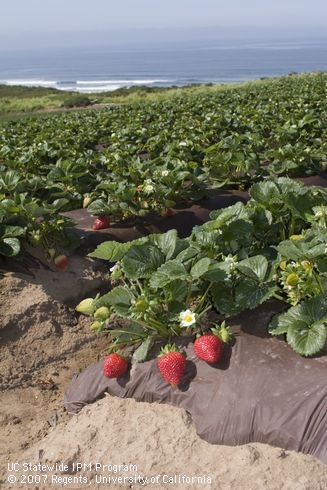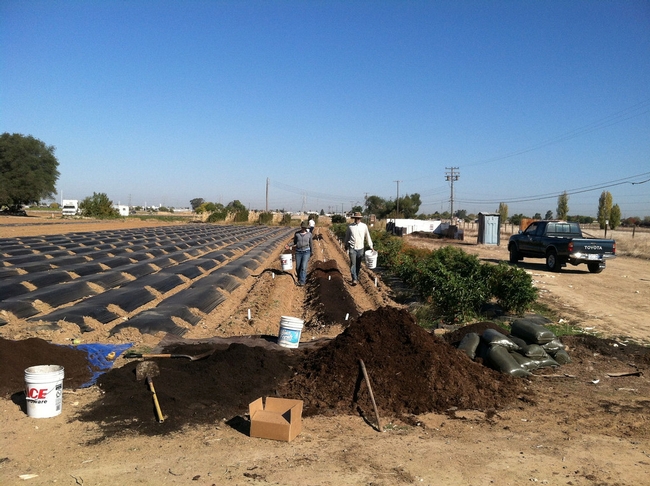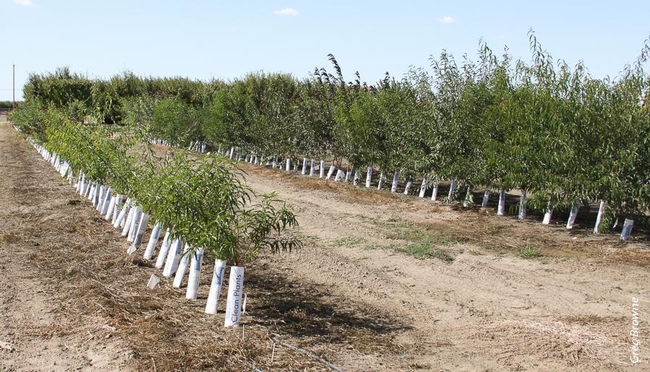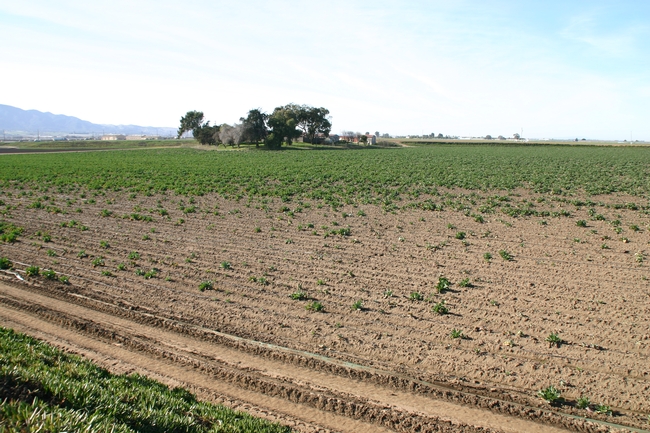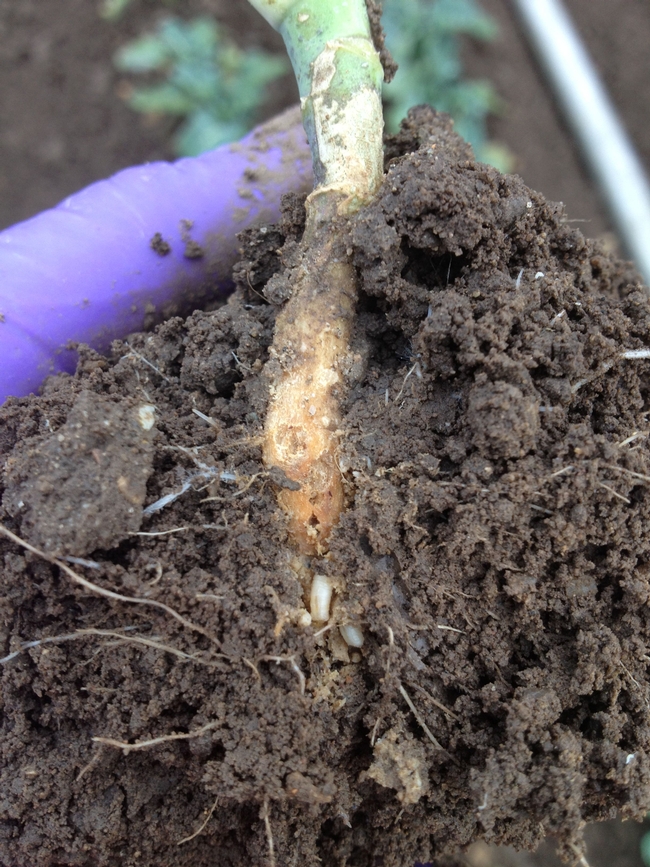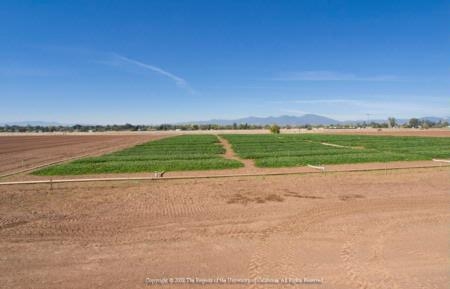Posts Tagged: methyl bromide
Strawberry producers need fumigant alternatives
When it was introduced more than 50 years ago, methyl bromide revolutionized the strawberry industry. The fumigant kills insects, nematodes, pathogens and weed seeds in the soil before the crop is planted in the field, reported Robert Gebelhoff in the Washington Post. However, because the chemical depletes ozone in the atmosphere, the US EPA has been trying to get farmers to stop using it.
Methyl bromide use has dropped dramatically over the years and is expected to be completely phased out by 2016, but strawberry farmers still don't have an alternative that works as well. Research is continuing.
"We're going to be using fumigants for a long time," said Steven Fennimore, UC Agriculture and Natural Resources Cooperative Extension specialist based at the USDA ag research station in Salinas. "They're relatively cheap and going all organic exposes you to a lot of pests."
Among the possible solutions shared in the Washington Post are:
- Finding and developing genetic resistance in strawberries to soil-borne diseases
- Anaerobic soil disinfestation, where a soil environment is created that is toxic for plant pathogens
- Steam injection
Fennimore suggests that there is unlikely to be a single tactic to replace methyl bromide.
"People talk about a silver bullet to replace it, and that's a mistake," Fennimore said. "We want to put a lot of treatments together and make it all work."
Can compost be an alternative to methyl bromide?
Writing on Earth Day, I am reminded of one of the world's major successes in environmental protection, the Montreal Protocol. Originally signed in 1987, it works to phase out ozone-depleting substanc
es, including the soil fumigant methyl bromide, commonly used by strawberry growers.Twenty-seven years later, the realities of enacting the Montreal Protocol are still taking shape, and strawberry growers are, with each harvest year, a step closer to a complete phase out of the fumigant and increased restrictions on alternative chemical fumigants used for disease suppression.
UC research has focused on how to make an economically viable and effective transition away from the soil fumigant. Initial alternatives include replacement chemical fumigants as well as biological fumigants such as anaerobic soil disinfection (such as putting tarps over fields to decrease oxygen), mustard seed meal amendment, or steam disinfestation.
But what if a practice many growers already use could also serve to suppress soil-borne diseases? What if growers could use a substance that provides multiple on-farm benefits?
Many conventional and organic growers alike use compost to boost soil fertility and organic matter. But compost's potential to serve other purposes, including suppressing disease, remain largely unexplored.
Ph.D. student Margaret Lloyd and Tom Gordon, professor in the Department of Plant Pathology at UC Davis, are hoping to close the gap in that knowledge. With a grant from the National Strawberry Sustainability Initiative, a program administered by University of Arkansas and funded by Walmart Foundation, and funding from UC Sustainable Agriculture Research and Education Program, Lloyd's research seeks to understand whether compost can contribute to disease suppression on a commercial scale, and how growers can best incorporate compost into their farm management to see its benefits.
“Compost is part of the production system that has potential as biological control,” says Lloyd. “Historically, we've only focused on it as a source of organic matter or soil nutrients. I'm trying to characterize its role in root health and soil health.”
The study evaluates the root health of strawberry plants, and compares plant yield and disease suppression across a number of research sites and compost types.
“In general, we talk about compost just as compost,” Lloyd said. “But it has drastically different qualities — soil fertility characteristics, physical properties, and microbial profiles. By focusing on different compost sources, the study will help growers better assess their available compost options to m
eet their farm needs.” Composts used in the study include worm compost, manure-based compost, spent mushroom compost, and municipal yard trimmings compost.Alternatives to methyl bromide have been a long time coming. “The research suggests that it won't be one technology replacing another, but a package of tools to help growers manage disease suppression in the soil,” Lloyd said. If some of those tools are already in a grower's tool kit, the transition away from fumigants will be that much smoother.
The research suggests a powerful Earth Day message for me: use what you have, but seek a deeper understanding of just how to use it.
Lloyd's research findings will be completed in 2014, with results available for growers in 2015. Visit the project's website for more information.
UC researchers help growers find alternatives to methyl bromide
A special collection of original research on methyl bromide alternatives is part of the July–September 2013 issue of California Agriculture, UC's peer-reviewed journal of agricultural, natural and human resources (http://californiaagriculture.ucanr.edu). Related articles will appear in the October–December 2013 issue.
Methyl bromide contributes to ozone depletion high in the atmosphere and was banned by developed countries in 2005 under the Montreal Protocol, an international treaty to protect the stratospheric ozone layer. Since then, the treaty has allowed limited use of methyl bromide for certain crops, but many of these exemptions are gone and the rest will end soon.
To develop and evaluate alternatives to methyl bromide, a team of UC and U.S. Department of Agriculture researchers was awarded a $5 million, five-year USDA grant. The project — called the Pacific Area-Wide Pest Management Program for Integrated Methyl Bromide Alternatives (PAW-MBA) — includes production crops such as grapes, strawberries and tree nuts as well as nursery crops such as cut flowers, forest trees and sweet potatoes.
"One goal of the program was to identify methyl bromide alternatives that were immediately useful and economically feasible," says Greg Browne, a USDA plant pathologist at UC Davis who coordinates the PAW-MBA program. "Another was to foster development of nonfumigant strategies for managing soilborne pests."
The team has identified methyl bromide alternatives that are both effective and economical for key California crops. When the best alternative is another fumigant, the researchers found ways to use less and to cut emissions. In addition, the researchers are developing alternatives that go beyond fumigants, including steam sterilization and other nontoxic approaches.
Summaries of projects and links to articles:
TIF film, substrates and nonfumigant soil disinfestation maintain fruit yields
Strawberry growers use methyl bromide primarily to control soilborne diseases. Now, new UC research shows that this crop can be grown without fumigants at small scales. Three nontoxic methods — nonsoil substrates, anaerobic soil disinfestation and steam disinfestation — produced strawberry yields as high as those in conventionally fumigated soil. “Instead of understanding soil, we've just been fumigating it," says Steve Fennimore, a UC Cooperative Extension specialist in Salinas who led this team. "Using physical tools is a different approach." Researchers will next evaluate whether these alternative methods can be scaled up to commercial production fields, and whether they work in different strawberry production areas of California.
Managing the almond and stone fruit replant disease complex with less soil fumigant
Almond and stone fruit growers need methyl bromide alternatives to control nematodes and Prunus replant disease, a soilborne disorder that stunts new orchards and cuts yields. To help these growers, UC and USDA researchers tested alternative fumigants, spot and strip fumigation and nonfumigant methods including rotating orchards with sudangrass and using nematode-resistant rootstock. “Spot treatments provided adequate control of Prunus replant disease and may be very helpful to growers needing to use less fumigant for costs savings or regulatory restrictions,” Browne says. In addition, integrating the various treatments tested may also help control the replant disease with less fumigant use.
Preplant 1,3-D treatments test well for perennial crop nurseries, but challenges remain
California supplies nursery stock to the state's fruit, nut and vineyard industries, as well as more than 60 percent of the rose plants and fruit and nut trees sold nationwide. This perennial nursery stock must be completely nematode-free, and growers use methyl bromide primarily to control these tiny soilborne worms. However, alternative fumigants such as 1,3-dichloropropene (1,3-D) don't work as well in fine soils. "We asked how we could make them work better," says Brad Hanson, a UC Cooperative Extension specialist in the Department of Plant Sciences at UC Davis. The researchers showed that 1,3-D controlled nematodes in fine soil when they tilled it deeper, injected the fumigant deeper and used tarps that kept more of the fumigant in the soil.
Fumigant emission reductions with TIF warrant regulatory changes
Fumigants are regulated partly because they help make smog. Totally impermeable film (TIF) can help keep fumigants in the soil and out of the air. New UC research shows that fumigant emissions can drop 64 percent when fields are tarped with TIF for twice as long as usual (10 days instead of 5). "We're now working on safe use," says Suduan Gao, a USDA soil scientist in Parlier who led the team. "The goal is to keep the fumigant under the tarp long enough that there won't be a surge in emissions when it's cut open." This work gives regulatory agencies a new way to let growers keep using enough fumigant to control pests and diseases while minimizing the smog-forming emissions.
The entire July–September 2013 issue can be downloaded at http://californiaagriculture.ucanr.edu.
California Agriculture is the University of California's peer-reviewed journal of research in agricultural, human and natural resources. For a free subscription, go to: http://californiaagriculture.ucanr.edu, or write to calag@ucanr.edu.
The University of California's Division of Agriculture and Natural Resources is the bridge between local issues and the power of UC research. UC ANR's advisors, specialists and faculty bring practical, science-based answers to Californians. Visit http://ucanr.edu to learn more.
WRITERS/EDITORS: To request a hard copy of the journal, email crllopez@ucanr.edu.
UC ANR scientists get $450,000 to study pesticide alternatives
UC ANR scientists get $450,000 to study pesticide alternatives
Two scientists in University of California Agriculture and Natural Resources have received grants from the California Department of Pesticide Regulation for research to improve crop yields and reduce the risks associated with pesticide use in California.
The root maggot, a pest of cole crops, can wipe out an entire field of broccoli or cauliflower by tunneling through the plants’ roots. With a new $302,542 grant from the Department of Pesticide Regulation, Shimat Joseph, UC Cooperative Extension advisor in Monterey County, will study ways growers can protect their high-value crops from this persistent pest.
“In the Salinas Valley, cabbage maggot infestation in a field can exceed 90 percent,” said Joseph, who specializes in integrated pest management.
To control the maggots, growers usually apply organophosphate insecticides, such as chlorpyrifos and diazinon, to the soil, but those chemicals don’t kill all of the destructive insects and may contaminate waterways. In hopes of finding more sustainable control methods, Joseph will study preventive tactics including multicropping, planting less-susceptible cultivars, changing cultural practices and using lower-risk pesticides.
Joseph, who specializes in entomology, will evaluate the susceptibility of broccoli when it is planted next to other various crops such as turnip, lettuce, cauliflower or cabbage, to see if the neighboring crop influences the broccoli field’s attractiveness to cabbage maggots. He will also evaluate different broccoli and cauliflower varieties for their resistance or tolerance to the maggots and will look into the role planting date in determining a plant’s susceptibility to the pest.
Lynn Epstein, professor in the Department of Plant Pathology at UC Davis, received a $153,289 Department of Pesticide Regulation grant to study alternatives to methyl bromide for strawberry nursery fumigation.
California produces more than a billion strawberry runner plants every year, with a total annual value of approximately $60 million. For the past 50 years, fumigating the soil with methyl bromide before planting has been the most effective way to keep soil-borne pathogens, nematodes and weeds from overwhelming strawberry nursery plants. In recent years, though, methyl bromide has become increasingly restricted, with the intention of eventually phasing it out entirely.
Anaerobic soil disinfestation integrates heat from solarization and oxygen deprivation from flooding, according to Epstein.
“We’ll incorporate a relatively inexpensive carbon source into the topsoil, irrigate it to field capacity, and then cover the amended soil with a plastic tarp,” Epstein said. The anaerobic byproducts that build up are toxic to pathogens, but those byproducts will degrade rapidly after the tarp is removed.”
Methyl iodide debate continues despite registration
In the 10 months methyl iodide has been registered in California, no one in Monterey County has used it or even applied to use it, but the debate over whether anyone should is fresher than ever, the Salinas Californian reported last week.
The soil fumigant methyl bromide, which growers have depended on for decades, will no longer be available starting in 2015. Methyl iodide, a potential substitute, is a harmful chemical, but can be used safely with proper precautions, said UC Cooperative Extension weed scientist Steve Fennimore.
"The professional fumigators are really good," Fennimore said. "If the public saw how the companies do the fumigation, they'd probably be more comfortable with them."
Another fumigant, chloropicrin, is widely used in combination with methyl bromide and methyl iodide to provide the most pest-free soil for growers.
"Chloropicrin is really strong against fungi, and methyl bromide is really strong against weeds," Fennimore said. "When you use them together, there's a synergy. They're very complementary."


